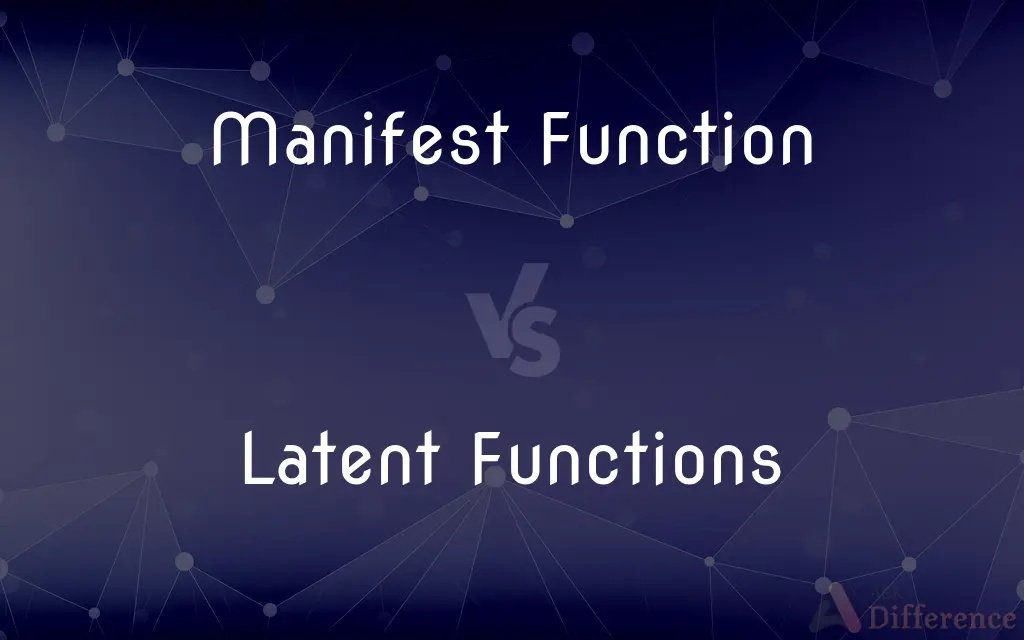Manifest Function vs. Latent Functions — What's the Difference?
By Maham Liaqat & Urooj Arif — Published on March 2, 2024
Manifest functions are intended and recognized outcomes of actions, whereas latent functions are unintended and often hidden consequences.

Difference Between Manifest Function and Latent Functions
Table of Contents
ADVERTISEMENT
Key Differences
Manifest functions refer to the explicit and intended outcomes of social processes or actions, serving as the recognized reasons behind social institutions or behaviors. These functions are deliberately designed to fulfill specific roles within society, such as education's role in imparting knowledge.
Latent functions, on the other hand, are the unintended, often overlooked consequences that do not reflect the overt purpose of social actions or institutions. For example, schools not only educate but also serve as venues for socialization and networking, which are latent functions.
Manifest functions are directly related to the objectives of social actions, whereas latent functions may indirectly contribute to or detract from the intended purpose. Latent functions can sometimes be more significant than the manifest functions, influencing social structures in profound but unnoticed ways.
The distinction between manifest and latent functions is crucial in sociology for understanding the complexity of social institutions and interactions. Recognizing these functions allows for a deeper analysis of how and why societies function, beyond the obvious or intended outcomes.
Both manifest and latent functions play a role in maintaining or challenging social stability. While manifest functions align with societal goals, latent functions can either reinforce social norms unintentionally or lead to unforeseen changes and adaptations within a society, showcasing the dynamic nature of social structures.
ADVERTISEMENT
Comparison Chart
Definition
Intended and overt outcomes of actions or institutions
Unintended and often hidden consequences of actions or institutions
Awareness
Generally recognized and acknowledged by society
Often unrecognized or unnoticed without deeper analysis
Purpose
Directly related to the objectives of the social action or institution
Indirect consequences that may not align with the original objectives
Impact on Society
Contributes to the explicit goals of societal structures
Can have a significant but unrecognized impact on societal dynamics
Examples
Education's role in knowledge acquisition
Education's role in promoting social networks and norms
Compare with Definitions
Manifest Function
Manifest functions contribute directly to societal goals.
Public transportation's manifest function is to facilitate mobility.
Latent Functions
A latent function is an unintended consequence of social institutions.
A latent function of schools is the development of social networks.
Manifest Function
They are openly stated objectives serving societal needs.
Schools' manifest function is to educate the youth.
Latent Functions
These functions are not always recognized but play a crucial role in society.
A latent function of social media is the creation of virtual support groups.
Manifest Function
A manifest function is an intended and recognized outcome of an institution.
The manifest function of hospitals is to provide medical care.
Latent Functions
Latent functions may either support or undermine the manifest functions.
A latent function of strict school policies can be the promotion of creativity in finding loopholes.
Manifest Function
These functions are easily identifiable and often cited as the reason for an institution's existence.
The manifest function of a library is to provide access to information.
Latent Functions
Latent functions can influence social behavior or structures in significant ways.
A latent function of religious institutions may be to provide a sense of community.
Manifest Function
Manifest functions align with the official purpose of social actions.
Law enforcement's manifest function is to maintain public order.
Latent Functions
They are hidden and may not align with the institution's explicit objectives.
A latent function of corporate team-building events is the reinforcement of hierarchical structures.
Common Curiosities
Can the same action have both manifest and latent functions?
Yes, most social actions and institutions have both types of functions, serving explicit purposes while also having hidden consequences.
How can latent functions become manifest functions?
Over time, if latent functions are recognized and valued by society, they can be intentionally incorporated and become manifest functions.
Are latent functions always positive?
No, latent functions can have negative consequences, depending on the perspective and the context in which they are analyzed.
Is there a clear boundary between manifest and latent functions?
The distinction can sometimes be blurry, as functions may shift or be reinterpreted over time and with changing societal values.
How do manifest and latent functions contribute to social stability?
Manifest functions directly support societal goals, while latent functions can indirectly contribute to or challenge social stability through their unintended effects.
Why are manifest and latent functions important in sociology?
They offer a comprehensive understanding of social institutions, revealing both the intended and unintended effects on society.
How do latent functions affect individual behavior?
Latent functions can subtly influence individual behaviors and attitudes, shaping social norms and expectations in ways not explicitly intended by social institutions.
How do sociologists identify latent functions?
Through observation, analysis, and sometimes unintended discoveries, sociologists can uncover the hidden consequences of social structures.
Can identifying latent functions lead to social change?
Yes, recognizing the unintended effects of social actions can inform policy adjustments or shifts in societal norms, potentially leading to change.
Can an institution have multiple manifest and latent functions?
Yes, most institutions and social actions have multiple functions of both types, reflecting the complexity of social interactions.
Share Your Discovery

Previous Comparison
Metamucil Tablets vs. Metamucil Powder
Next Comparison
Active Water Absorption vs. Passive Water AbsorptionAuthor Spotlight
Written by
Maham LiaqatCo-written by
Urooj ArifUrooj is a skilled content writer at Ask Difference, known for her exceptional ability to simplify complex topics into engaging and informative content. With a passion for research and a flair for clear, concise writing, she consistently delivers articles that resonate with our diverse audience.
















































